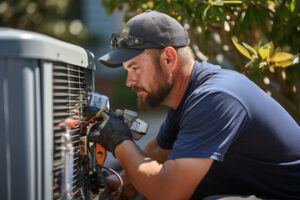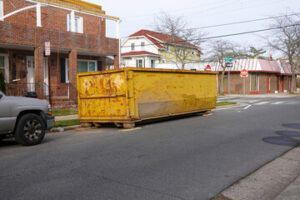HVAC contractors can save customers money and protect the integrity of a system by quickly spotting minor problems. This allows them to address them before they become major, costly repairs.

An HVAC system regulates indoor temperatures and humidity, creating a comfortable, consistent climate. They come in many sizes and types, with some able to pump heat out as well as into buildings. Contact Berlin Heating And Cooling for professional help.
Whether it’s heating a home or cooling an office building, HVAC technology regulates temperature, air quality and circulation. To do so, it draws in outside air and filters it for pollutants, then circulates it through a building to keep indoor environments comfortable. Its three primary functions are heating units that raise indoor temperatures, ventilation systems that circulate air and air conditioning units that maintain cool temperatures and dehumidify.
The process of moving warm and cold air around a home or business is overseen by sophisticated control systems that adjust to external conditions and user preferences. While the details vary by system type, all HVAC equipment shares basic elements. In the case of residential HVAC systems, they include an outdoor unit that houses a compressor and condenser coil, an indoor air handler with an evaporator coil, ductwork to funnel air throughout the home and a blower. The air conditioner is the most familiar of all HVAC equipment, but it’s important to note that there are different types of ACs based on their capacity and energy efficiency.
Most modern HVAC systems are split into two components; an indoor unit that contains the evaporator coil and blower, and an outdoor unit that housed the compressor and condenser coil. Split systems are versatile and can be used for both heating and cooling. In general, the evaporator coils draw in ambient air and force it over a refrigerant-cooled, closed-loop coil. This process removes heat from the air, which is then blown into the ductwork and circulated to all rooms in a home or office. The cooled air is then pushed back outdoors through the same process, and the cycle begins again.
Evaporator Coils
Evaporator coils are the core of your HVAC system’s heat exchange process. Located either on your furnace or inside the blower compartment of an air handler, they suck in warm indoor air and work with your outdoor coil to complete the exchange process that cools your home’s interior.
The coils consist of a network of copper tubes with metal fins designed to facilitate the transfer of heat. As a liquid refrigerant circulates through the evaporator coils, it absorbs heat from the warm indoor air. This raises the pressure of the refrigerant, which then turns into a gaseous state. The system’s blower then moves the air across the coils’ cold surface, causing it to cool down (Trane).
As the refrigerant continues to cycle, it passes through an expansion valve, decreasing its pressure once again and returning to its liquid state. It then moves back through the evaporator coils, and the process starts again. The evaporator coils can be both cased or uncased, vertical or horizontal, and “A”-shaped or “Z”-shaped (Behr).
Because the coils are in direct contact with the air that the system sucks into them, they must be kept clean. Dirty, damaged or obstructed coils will prevent your HVAC system from cooling efficiently and can increase your energy consumption.
When it’s time for the evaporator coil to be cleaned, a licensed Jewell Mechanical technician will remove an access panel that secures the coil. Then, using a spray foam solution that’s specially formulated for coil cleaning, the technician will soak the coil passageways and remove any debris or contaminants (Pick HVAC). The coils will then be rinsed with water to flush out any remaining moisture before they’re replaced.
Ductwork
Your HVAC system has many parts that all work together to keep your home comfortable. One of the most important is the ductwork, which provides a network for air to flow throughout your house. Ductwork is often overlooked or ignored, but it plays a crucial role in the functionality of your heating and cooling system.
There are several different types of ductwork, each with its own benefits and drawbacks. Some of the most common are rectangular metal ducts, which are made from bent pieces of sheet metal that are cut and fused together. Others are flexible plastic and fiberglass ducts, which offer greater flexibility than rigid steel ducts. A duct’s size and material affect how well it insulates and circulates air. It also impacts its strength and durability.
The ductwork network includes supply and return ducts, vents, air handlers, filters, dampers, and the plenum. The supply ducts deliver conditioned air into your home, while the return ducts carry stale air back to the HVAC system for reconditioning. The air handlers move the conditioned air around the house, and the filters prevent contaminants from being circulated into rooms. Dampers control the amount of air flow through each duct.
Ducts need to be properly sized and installed for your HVAC system to work effectively. If ducts are too big or too small, they may leak, which wastes energy and can cause poor indoor air quality. A professional can determine if your ducts are the right size and can suggest improvements to optimize performance.
Vents
Vents are the gateways that allow conditioned air to flow into the various rooms of your home or building. They distribute the conditioned air from the HVAC system and help ensure proper air pressure balance, quality and temperature in each room.
There are different types of vents, each designed for a specific purpose. For example, floor vents are ideal in cold climates for distributing warm air efficiently, while ceiling vents excel in cooling setups by delivering cooled air evenly across the space. Depending on the type of vent, you can customize its positioning in your living spaces by moving it to a different location, or by installing decorative covers.
The most important thing to remember is that you should never close the vents in unused rooms. Closing the vents can cause the HVAC system to work harder, increasing energy consumption and shortening its lifespan. In addition, closing the vents can restrict airflow and increase the amount of time it takes to reach your desired temperatures.
Another key point is the difference between supply and return vents. The supply vents blow conditioned air into the room, while the return vents pull stale indoor air back into the HVAC system for reconditioning. The return vents are usually larger in size to accommodate a higher volume of air. To determine which type of vent is in use, simply place your hand or a piece of paper over the vent opening and feel for air flow or suction.
You should also regularly clean your vents to prevent a buildup of dust and other debris that can interfere with the airflow. In some cases, you may need to hire a professional to perform a thorough cleaning of your vents and ductwork. Regular duct cleaning can keep allergens from spreading throughout your home and ensure that the HVAC system runs at its optimal performance level.
Refrigerant
Refrigerant is a chemical compound that can easily shift from liquid to gas, which allows it to absorb and transfer heat from your home to the outside air. Most HVAC systems use R-22 (chlorinated hydrocarbon) or R-407C (hydrogen chloride), though other options exist, especially in newer equipment.
The EPA’s 2025 refrigerant regulations will phase out older refrigerants with high global warming potential in favor of lower-GWP options like R-454b (a blend of R-32 and hydrofluoroolefin). Fortunately, the current refrigerants will still be useful for repairs on existing systems for quite some time.
Air from your house passes over evaporator coils inside the air handler, which cools it by blowing over the refrigerant. This is why it’s important to maintain your system and keep it free of leaks. If you have a leak, your refrigerant will lose its ability to absorb heat and won’t be able to effectively cool the space.
After the air leaves the evaporator coil, the liquid refrigerant moves to the outdoor condenser unit where it is pushed across the copper tubing by the fan. This causes condensation, which releases the absorbed heat into the air. The refrigerant then moves to the compressor, where it reduces its volume and becomes a high-pressure gas around 150degF. This is then pumped through an expansion valve, which lowers its temperature and pressure to about 100degF, changing it back to its liquid state.
From there, it’s pumped back through the evaporator coils in the air handler and into your home. It carries the cool air throughout your home until the thermostat signals it to stop. This process can remove smoke, bacteria, odors, carbon dioxide, and other gases from your indoor air, making it healthier for you to breathe.


